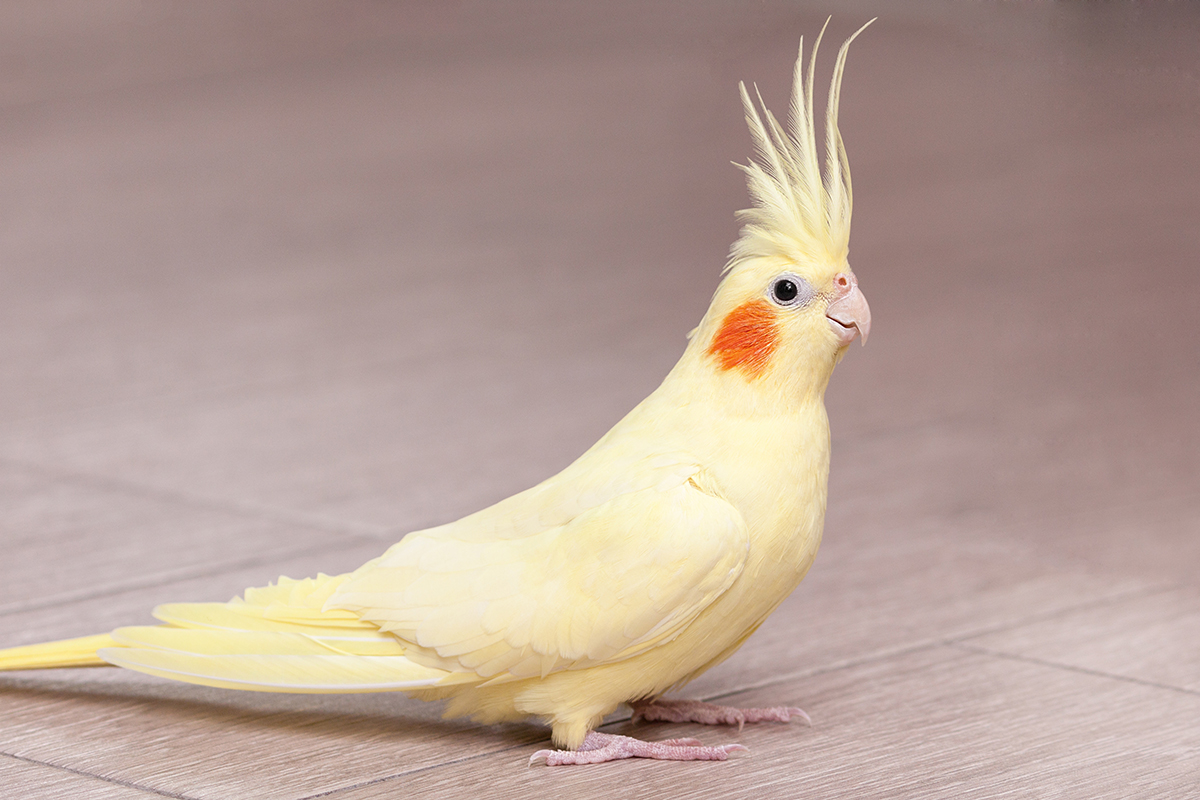Everything You Need to Know About Pet Cockatiels
Cockatiels easily woo bird lovers with their gentle, affectionate personalities. They tend to bond easily with humans during playtime and will even whistle along to your favorite tune, showing off their intelligence and camaraderie.
Or maybe you're attracted to this petite parrot's feathery, funky mohawk. It's called a crest and allows the pet to express his mood, making it easy to connect with your birdy buddy. Feathers up? I'm listening, curious, excited, and ready for attention. Feathers down? Ease up. I'm sleepy, feeling calm, or need my space!
We reached out to Monika Sangar, the co-founder of the Prego Dalliance Sanctuary in California, to learn more about cockatiels. At her parrot rescue, she provides a loving, safe home and health care for homeless, unwanted, and special needs birds.
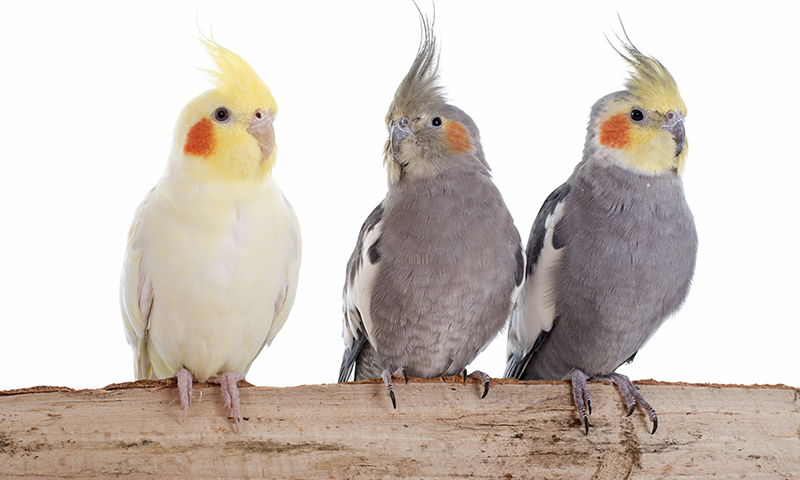
Yellow cockatiel perched next to two pied cockatiels.
What Colors Are Cockatiels?
Cockatiels flaunt five main colorations; however, selective breeding over the years boasts even more options, Sanger explained. For example, cockatiels from years ago almost always sported orange cheek feathers. Some cockatiels now lack this colorful identifier.
Most cockatiels fit into one of these color categories:
-
Gray: A dark gray body with white wing bars, a yellow face (in mature males), and vibrant orange cheek patches make up the most popular, iconic cockatiel coloring. This reflects the appearance of most cockatiels in the wild.
-
Cinnamon, fallow, and silver: These three colors appear softer, as muted versions of the classic gray bird. The cinnamon option almost shows as a light brown tone, hence the name.
-
Lutino: This bright, bold, all-yellow bird has flashy orange cheeks. When shopping in pet stores for a cockatiel, you're most likely to see lutinos or grays.
-
Pearl: White speckles on the bird's back and wings make it a pearl variety. This fancy enhancement does fade over time in males.
-
Pied: If you spot a cockatiel with patches of yellow and white randomly mixed with larger areas of gray, you have a pied bird.
What Sounds Do Cockatiels Make?
Although cockatiels don't talk as much as larger parrots, they do vocalize. Male cockatiels tend to show off their skills more than females by mimicking sounds around the house, like a beeping microwave or your favorite television show theme song. They can also learn to speak a few simple words or phrases.
Cockatiels also make sounds to communicate with you.
"A cockatiel can let out a sharp 'Wheet!' when you leave the room. That's a contact call. They are just asking, 'Where are you?' Or, it can be considered a flock call," Sanger educated. "Cockatiels can also hiss, which is a warning sound asking to be left alone or telling you they're scared."
How Big Do Cockatiels Grow?
Cockatiels are small parrots, or psittacines, which include birds with curved beaks, clawed feet, and an upright sitting stature. They measure approximately 11 to 13 inches from head to tail tip and weigh up to 4.5 ounces as adults. When they stretch their wings, the span can measure 12 to 14 inches. Cockatiels tend to reach their adult size around 8 to 12 weeks of age.
Sangar says your pet cockatiel needs at least a medium-sized bird habitat of approximately 27 inches wide by 24 inches deep with a horizontal design, sometimes called a "flight cage." These longer homes allow for more flying movement than taller options.
But as always with parrots, the larger the home, the better. This allows room for flight and several perches of various sizes, materials, and heights to hop among. Just don't place perches directly above food or water, as droppings may contaminate the bowls.
"Cockatiels are natural explorers. If they're not flying, they'll often climb around their aviary or perch, trying to get a better view of everything. Keep plenty of toys and safe climbing spots available for them to explore," she added.
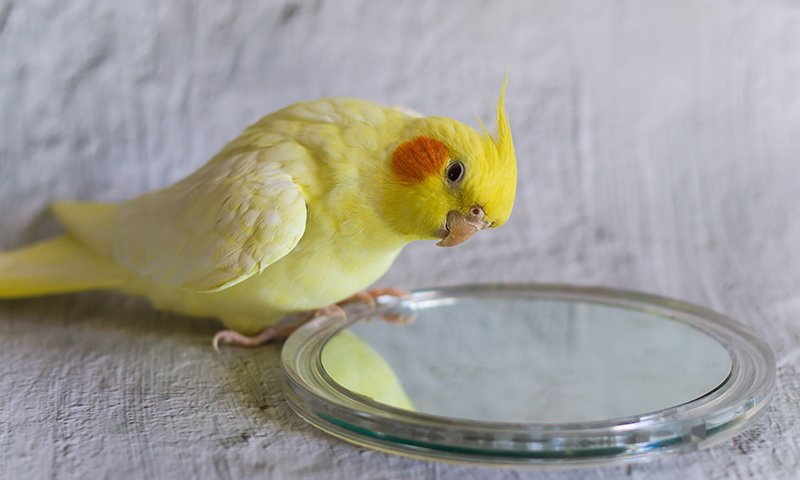
A cockatiel looking at his reflection in a mirror.
Do Cockatiels Like Toys?
Yes! Cockatiels love toys, especially ones they can nibble. Sangar suggested choosing bird toys made of soft woods, like balsa and sola, or plain paper. It's a bonus if the toy also contains a bell. Cockatiels love this sound and will nibble at the bell to make it ring.
Your pet may also enjoy a bird swing inside the aviary. This toy encourages movement and exercise as the cockatiel works to balance on the swaying object.
Does your bird seem to love digging around in his food bowl? Offer a foraging toy! Fill a small toilet paper tube with treats, then crimp both ends. Set it on the bottom of the bird habitat and let your pet discover how to open and enjoy the toy.
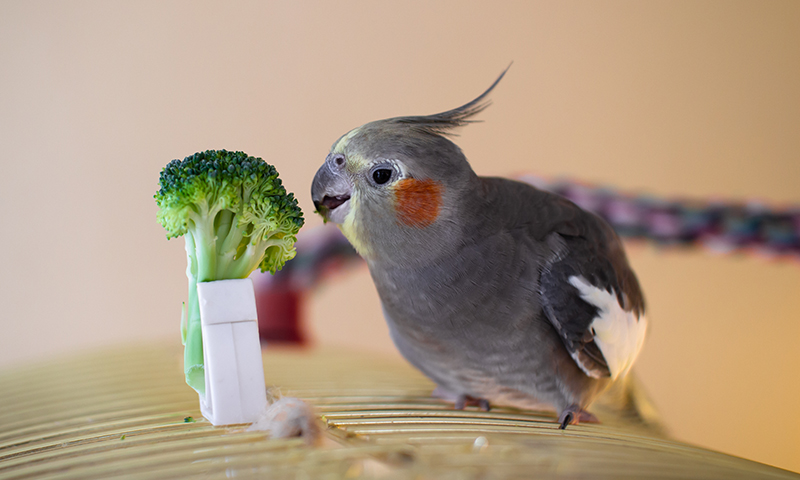
Grey (pied) cockatiel eating a broccoli floret.
What Do I Feed My Cockatiel?
Like many parrots, cockatiels do best when fed a varied diet and fresh water daily.
Sangar said, "Cockatiels should always have access to healthy fresh foods like veggies, greens, grains, and fruits. Pellet bird food, seeds, and nuts can be part of their healthy diet. They do like cuttlebone and millet (unflavored). But they can't be on an all-seed diet."
For your cockatiel's main diet, consider one of these foods:
-
Kaytee Exact Rainbow Cockatiel Food: This pelleted nugget-style food features Omega 3s for brain and heart health, as well as prebiotics and probiotics for digestive health. You'll also love that it doesn't contain any seed hulls or shells for less mess.
-
Kaytee Fiesta Cockatiel Food: Created by a pet bird nutritionist, this blend offers a mix of shapes and textures to stimulate your pet's natural foraging instincts. He will sort through seeds, grains, dried fruits, veggies, and so much more.
-
Kaytee Food From The Wild Cockatiel: Your cockatiel will enjoy sorting through this blend of foods commonly found in the wild by parrots, including papaya, pineapple, almonds, bell peppers, and ground green peas mixed with extruded pellets to offer optimal nutrition support.
-
Kaytee Forti-Diet Pro Health Cockatiel Food: Rich in antioxidants, Omega 3s, prebiotics, and probiotics, this bird food blend features a mix of nuts, fruits, veggies, seeds, grains, and more to support skin and feather health.
-
Kaytee Forti-Diet Pro Health Cockatiel Food with Safflower: Does your bird go straight to safflower seeds first? Then this blend is for him! Developed by an avian nutritional expert, this cockatiel diet offers a mix of antioxidant-rich seeds, grains, and pelleted food.
-
Kaytee Forti-Diet Pro Health Egg-Cite! Cockatiel Food: Is your bird molting (a natural shedding of feathers)? This seed, grain, and pellet blend comes enriched with egg crumbles to offer extra protein, vitamins, minerals, and essential amino acids to support skin and feather health.
You may also offer your pet a daily tablespoon or two of chopped, fresh (uncooked, unseasoned) dark green or yellow produce such as:
-
Kale
-
Broccoli
-
Romaine
-
Spinach
-
Peas
-
Yellow squash
-
Pineapple
-
Mango
-
Yellow carrot
Avoid iceberg lettuce or cabbage as they may cause diarrhea in birds. And remove any fresh foods from your pet's habitat after about two hours, before they spoil.
During play and training, you may want to offer your bird a little treat. Keep a variety of convenient, packaged options on hand. Cockatiels enjoy a sprinkle of Kaytee Bird Greens Treat for All Pet Birds made with alfalfa, parsley, kale, chia seed, and sweet potatoes on top of their daily food. Or try a Kaytee Avian Blueberry Superfood Treat Stick. Simply hang it on the side of the aviary and let your feathered friend nibble at the blend of dried blueberries, grains, and seeds.
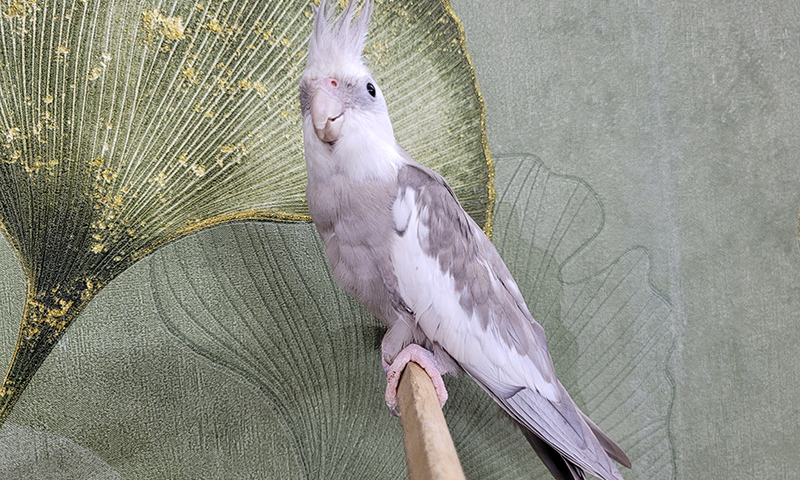
Cinnamon cockatiel sitting on a perch.
How Can I Bond with My Cockatiel?
You can form a loving connection with your cockatiel. Start by spending time near his habitat and talking, singing, whistling, or reading to him. Sangar said doing this consistently builds trust. You may also want to hand treats, such as a millet spray, through the bars to win extra awesome pet parent points.
When you initially bring your pet home, he may become suspicious and try to bite. Avoid sudden movements and let the bird familiarize himself with his new home.
Then, create a daily routine that allows you and your bird to bond over familiar tasks, including refilling fresh water, offering new food, and tidying up the aviary.
Once your pet starts lingering by the door of the aviary, you can venture into touching and training.
"Let them come to you on their terms. Avoid rushing or forcing contact," Sangar reminded. "The way a cockatiel is raised plays a major role in its temperament. If the bird wasn't hand fed, it may not be as cuddly or eager for head scritches."
Once your bird approaches you, offer gentle head rubs, which show trust and affection. Or you may want to work on training simple tricks, like "step up" onto your finger or a perch, or target training, to build your connection and boost confidence in your bird.
"Cockatiels love structure, so keep feeding, play, and quiet time consistent," Sangar explained.
Nurture a bond with your pet cockatiel by building a routine of engagement. Maybe you chat and whistle together during your morning coffee and work on training in the afternoons.
Cockatiels enjoy a nice long lifespan — 10 to 14 years — similar to that of a pet cat or dog. Some cockatiels have managed to live into their early 20s! Bonding with your pet early on will ensure many years of a playful partnership.
Cockatiels Make Great Small Parrot Pets
Thanks to their petite stature, cockatiels often become a parrot lover's first feathered pet. The attractive color options, fun vocalizations, and ability to keep them in a medium-sized aviary attract owners; however, these birds need just as much TLC as larger parrot species.
"Cockatiels may be smaller and less expensive than parrots, like macaws or cockatoos, but they still require the same level of attention, care, and commitment. They thrive on social interaction, mental stimulation, and bonding with their owners," Sangar shared. "Just like larger parrots, cockatiels need a balanced diet, access to proper veterinarian care, regular playtime, and enrichment to keep them happy and healthy."
Learn more about caring for your bird in the New Pet Cockatiel Checklist.
